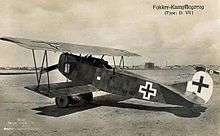Franz Büchner
Franz Büchner (2 January 1898 – 18 March 1920) was one of the most successful German fighter aces of the First World War, shooting down 40 enemy aircraft. He survived the war, but died in 1920 while combating communist revolutionaries.
Franz Büchner | |
|---|---|
| Born | 2 January 1898 Leipzig, Kingdom of Saxony, Germany |
| Died | 18 March 1920 (aged 22) Near Leipzig |
| Allegiance | Germany |
| Service/ | Infantry, flying service |
| Years of service | 1914–1920 |
| Unit | 7th Infantry Regiment #106, FFA 270, Jasta 9, Jasta 13 |
| Awards | Pour le Merite, Royal House Order of Hohenzollern, Iron Cross 1st and 2nd Class, Saxon Military Order of St. Henry, Saxon Albert Order |
Early career
Büchner was born in Leipzig in the Kingdom of Saxony, the son of a businessman. He volunteered for the army in September 1914, aged 16.[1] He served in the Royal Saxon 7th Infantry Regiment Nr. 106 (Kgl. Sächsisches 7. Infanterie-Regiment König Georg Nr. 106). After surviving a case of typhoid fever, he fought on both the Eastern and Western fronts.[2] He was subsequently commissioned in 1916 shortly after his 18th birthday.[1] He was wounded in combat in France on 3 April 1916.[2] After his recovery, he transferred to the German Army Air Service, or Luftstreitkräfte, and was assigned as an observation pilot with FFA 270.[1]
Service as fighter pilot
In March 1917 Büchner became a fighter pilot, joining the Prussian Jagdstaffel 9 where he scored his first and only victory with them, on 17 August.[1] Upon his transfer to Jagdstaffel 13, he found his niche under Rudolph Berthold, one of Germany's most dedicated soldiers.[3] However, it was several months before he scored again, on 15 October.[2]
With the introduction of the Fokker D.VII in 1918, Büchner came into his own; he flew at least three different machines during his career, scoring three victories in June and becoming Commanding Officer of the Jasta on 15 June.[4] It was after his fifth victory that he landed and announced to his squadron colleagues that he had now learned how to win in aerial combat. It was a prescient statement.[5]
On 2 July, he shot down and killed "The Mad Major", Irish 5-victory ace Major Joseph Callaghan, CO of No. 87 Squadron, who was flying a Sopwith Dolphin in a solo attack on Jasta 13.[6] Five days later, he followed up with Canadian ace Lieutenant Merrill Taylor (7 victories), killed in a Sopwith Camel of No. 209 Squadron.[2]

On 29 July 1918 Büchner shot an American Sopwith Camel down in flames with just 14 rounds. His wingman, Leutnant Werner Niethammer, cited this combat as an illustration of Büchner's skill as a marksman; according to Niethammer's account, Büchner had no sooner spotted the American than he had set the enemy aircraft on fire.[7] This would be the last of his seven victories in July.[2]
On 10 August, Büchner's career nearly ended. While attacking and shooting down a two seater in bad flying weather, his plane's fuel tank was hit. Drenched in gasoline, he landed in no man's land and tagged along with two retreating German machine gunners.[8] The incident does not seem to have slowed him down. It was the second of his eight victories in August.[2]
In September Büchner scored 17 victories, the top scoring German fighter pilot for the month. [9] On 10 October, Büchner survived a mid-air collision with fellow Jasta pilot Michaelis; both of them parachuted to safety.[10]
He brought his tally to 40 victories by 22 October 1918.[2] Three days later he was awarded the Pour le Mérite on 25 October 1918, one of the last awards before the Kaiser's abdication.[2] Having downed 38 of his 40 victories in the Fokker D.VII, in a span of five months, he's the most successful pilot in the type.
Post war service
In the turbulent postwar period the 22-year-old Büchner flew against communist revolutionaries but was shot down and killed by members of the Spartacus League during a reconnaissance flight near his hometown of Leipzig on March 18, 1920, three days after Rudolf Berthold was murdered in Harburg.[11]
Decorations and awards
Besides the Pour le Mérite, Prussia's highest military honor, Büchner also received the highest military honor of his home state, Saxony's Military Order of St. Henry (Militär-St. Heinrichs-Orden), on October 7, 1918.[12] Büchner's other decorations include the Prussian Iron Cross 1st and 2nd Class,[13] the Knight's Cross with Swords of Prussia's Royal House Order of Hohenzollern,[14] the Knight's Cross with Swords of Saxony's Merit Order, and the Knight's Cross with Swords of Saxony's Albert Order.[15]
Sources cited
- "Lt. Franz Buchner". www.century-of-flight.net. Retrieved 2009-07-25.
- "Franz Buchner". www.theaerodrome.com. Retrieved 2009-07-25.
- Jagdgeschwader II Geschwader 'Berthold'. p. 11.
- "Jasta 13". www.theaerodrome.com. Retrieved 2009-07-25.
- Fokker D.VII Aces of World War I. p. 57.
- Jagdgeschwader II Geschwader 'Berthold'. p. 75.
- Fokker D.VII Aces of World War I. pp. 57–59.
- Jagdgeschwader II Geschwader 'Berthold'. p. 81.
- Above the Lines, Shores, page 239
- "Parachute use in World War I". www.ejection-history.org.uk. Archived from the original on 2010-12-15. Retrieved 2009-07-25.
- Above the Lines, Shores, page 86.
- "Military Order of St. Henry". www.theaerodrome.com. Retrieved 2009-07-25.
- "Iron Cross". www.theaerodrome.com. Retrieved 2009-07-25.
- "Royal House Order of Hohenzollern". www.theaerdrome.com. Retrieved 2009-07-25.
- "Order of Albert". www.theaerodrome.com. Retrieved 2009-07-25.
External links
References
- Above the Lines: The Aces and Fighter Units of the German Air Service, Naval Air Service and Flanders Marine Corps, 1914-1918. Norman L. R. Franks, Frank W. Bailey, Russell Guest. Grub Street, 1994. ISBN 0-948817-73-9, ISBN 978-0-948817-73-1.
- Fokker D VII Aces of World War I. Norman Franks, Greg VanWyngarden. Osprey Publishing, 2003. ISBN 1-84176-533-3, ISBN 978-1-84176-533-4.
- Jagdgeschwader Nr II: Geschwader Berthold. Greg VanWyngarden. Osprey Publishing, 2005. ISBN 1-84176-727-1, ISBN 978-1-84176-727-7.